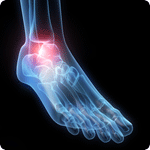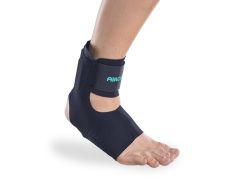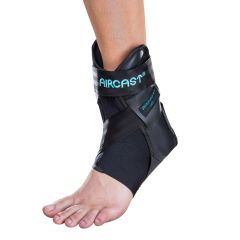Adult-Acquired Flatfoot (Posterior Tibial Tendon Dysfunction)

The posterior tibial tendon, which stretches from the calf to the bones in the middle of your foot, is one of the most important tendons in the lower leg. Adult-acquired flatfoot, also known as fallen arches or posterior tibial tendon dysfunction (PTTD), is a painful condition that occurs when this tendon becomes inflamed, overstretched or torn. This leads to the flattening of one foot—or sometimes both feet—with lower arches.
What Causes PTTD (Flat Feet)?
The posterior tibial tendon begins at one of the smaller muscles of the calf, runs through the middle of the ankle, and connects to the bottom of the foot. This tendon helps maintain the arches and normal alignment of your foot, and provides support so you can walk normally. When this tendon gets damaged for any reason and the arch of the foot flattens, it results in PTTD.
PTTD only occurs in adults and it affects females about four times as frequently as males, which is why it's most common in women between the ages of 40-60. There are many factors that can contribute to PTTD, but it usually develops from overusing the posterior tibial tendon. This wear-and-tear of the tendon tends to occur gradually over time from participating in too many activities that strain the feet. People who run frequently and those involved in high-impact sports like basketball, tennis or soccer are therefore at a higher risk for PTTD. Other risk factors for PTTD include:
- Already having flatfoot or flatfeet
- Diabetes
- Obesity
- High blood pressure (hypertension)
- Previous injury or surgery of the posterior tibial tendon
What are the Symptoms?
In some individuals, flat feet may not cause any symptoms or problems. When symptoms do occur, patients typically experience the following:
- Pain along the inside of the foot and ankle
- Swelling, redness and warmth may also occur in that area
- As PTTD gets progressively worse and the arch continues to flatten, these symptoms will often move to the outside of the ankle and foot
- The flattening of the arch also causes the ankle to roll inward
- Symptoms usually get worse after engaging in physical activities, especially those that put lots of pressure on the feet like running and jumping
- Some patients have difficulty standing for a long time or standing on their tip toes
- In a few patients, flat foot may also contribute to low back pain
What is the Treatment?
If you have flat feet and it doesn't cause any pain, treatment may not be needed right away. When symptoms develop and you start to notice changes in your arch, you should see a medical professional like a podiatrist as soon as possible. Early treatment is very important for flatfeet, as not doing anything about it can eventually lead to extreme flatfoot. To diagnose the condition, a full-scale evaluation with a physical exam and patient history will be performed. A very helpful test often used to determine if PTTD is present is the single heel raise, in which the patient stands on one foot and rises up on their toes. In some cases, an x-ray or MRI may also be used to gather additional information.
For most cases of PTTD, conservative (non-surgical) treatment is recommended at first before other options are considered. If treatment begins early enough and the condition hasn't progressed too far, flat feet will improve and symptoms will be alleviated after some time. Conservative treatment strategies usually include the following:
Rest
Temporarily stop activities that put lots of stress or pressure on the feet; in severe cases, you may need to avoid all activities that put weight on the foot.
Brace/Orthotic Device
Wearing a brace or support, sleeve, or placing an orthotic device in your shoe will provide your arch with the support it needs; the Aircast Airlift PTTD includes an adjustable “aircell” under the arch that helps shape the foot into a natural position.
Immobilization
A short-leg cast or boot may be recommended to prevent the foot from moving, which will give the injured tendon some time to heal.
Shoe Modifications
If your shoes are worn out, don't fit properly or don't provide enough arch support, you should replace them with a more appropriate pair.
Physical Therapy
You may also need a course of physical therapy to address your condition; exercises to stretch and strengthen the foot and lower leg muscles should help improve your motor control and reduce pain levels.
Surgery
When conservative treatment doesn't lead to improvements or PTTD has already progressed too far, it may be time to consider surgery. You should discuss all available options with your doctor, but some of the common procedures performed for flat feet include cutting out a piece of bone (osteotomy), removal of the inflamed tendon and implants to realign the foot. As with any type of surgery, there are risks involved and ample recovery time will be needed.
Can PTTD be Prevented?
Although there are no specific methods that have been proven to prevent PTTD, there are some general guidelines that may reduce your chances of developing it:
- Since diabetes, high blood pressure and being overweight are risk factors, try to maintain good overall health and address any of these conditions if you're at risk
- Make sure you're wearing appropriate shoes that fit well and have good arch support when engaging in any type of physical activity
- If you participate in any sport that has a high risk for flatfeet, be sure to take breaks regularly and try changing it up with other activities from time to time
- Remember to seek out treatment early if you're dealing with any symptoms that may suggest flatfeet






